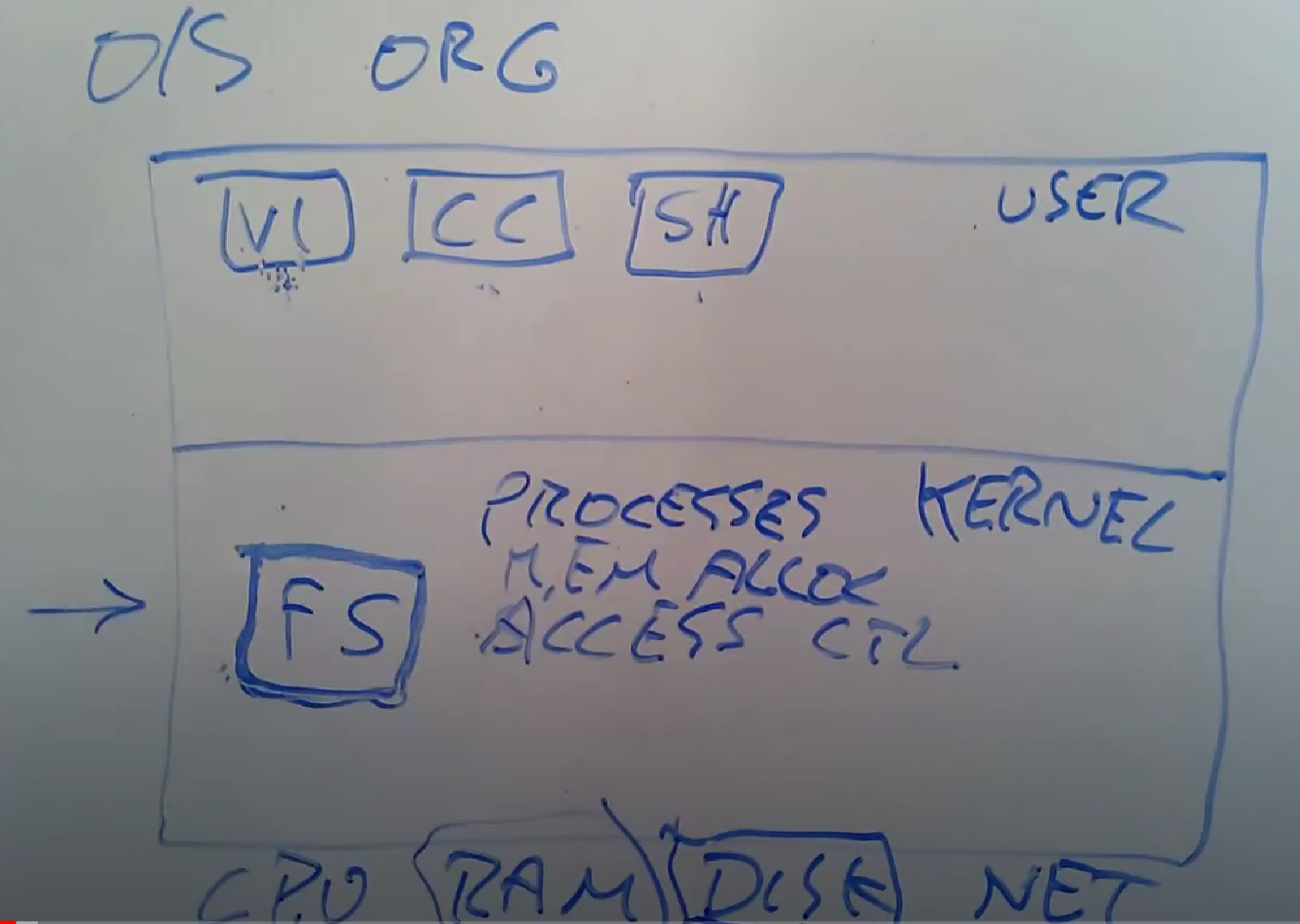
MIT6.S081笔记:lecture 1
care about what is going on under the hook
like infrastructure
care about high performance
Course Goals
- OS design and implementation
- Hands-on experience extending a small os
- Hands-on experience writing systems software
OS Purposes
- ABSTRACTION of the hardware for convenience and portability
- MULTIPLEX the hardware among many applications
- ISOLATION
- SHARING among cooperating applications
- SECURITY(PERMISSION)
- PERFORMANCE
- RANGE of USES
OS ORGANIZATION

- user app: vi, gcc, DB, &c
- kernel services
- hardware
we care a lot about the interfaces and internal kernel structure
What services does an O/S kernel typically provide?
- process
- memory allocation
- file contents
- file names, directories
- access control(securities)
- many others: users, IPC, network, time, terminals
What’s the kernel interface?
- “System calls”
- like open()
- write()
- fork()
Why is O/S design+implementation hard and interesting?
- unforgiving environment: hard to debug
- many design tensions:
- efficient vs abstract/portable/general-purpose
- powerful vs simple interfaces
- flexible vs secure
- features interact:
fd = open(); fork() - uses are varied: laptops, smart-phones, cloud, virtual machine, embedded
- evolving hardware: NVRAM, multi-core, fast networks
API for the Kernel
- fd = open(“out”,1)
- write(fd,”hellp\n”,6)
- pid = fork();
system calls are special because they jump into the kernel
Why studying operating system both challenging and interresting?
unforgiving
tensions
- efficient - abstract interfaces
- powerful os services - simple interfaces
- flexible - secure
interact
1 | fd = open() |
Class structure
Online course information:
https://pdos.csail.mit.edu/6.S081/ – schedule, assignments, labs
Piazza – announcements, discussion, lab helpLectures
- O/S ideas
- case study of xv6, a small O/S, via code and xv6 book
- lab background
- O/S papers
- submit a question about each reading, before lecture.
Labs:
The point: hands-on experience
Mostly one week each.
Three kinds:
Systems programming (due next week…)
O/S primitives, e.g. thread switching.
O/S kernel extensions to xv6, e.g. network.
Use piazza to ask/answer lab questions.
Discussion is great, but please do not look at others’ solutions!Grading:
70% labs, based on tests (the same tests you run).
20% lab check-off meetings: we’ll ask you about randomly-selected labs.
10% home-work and class/piazza discussion.
No exams, no quizzes.
Note that most of the grade is from labs. Start them early!
Introduction to UNIX system calls
- what happens when a program calls a system call like open()?
looks like a function call, but it’s actually a special instruction
hardware saves some user registers
hardware increases privilege level
hardware jumps to a known “entry point” in the kernel
now running C code in the kernel
kernel calls system call implementation
open() looks up name in file system
it might wait for the disk
it updates kernel data structures (cache, FD table)
restore user registers
reduce privilege level
jump back to calling point in the program, which resumes
we’ll see more detail later in the course
fork.c
the shell create a new process for each time you type
the fork() system call create a new process
the kernel makes a copy of the calling process
instructions,
data,
registers,
file descriptors,
current directory
“parent” and “child” processes
only difference: fork() returns a pid in parent, 0 in child
How can we run program in that process?
exec.c
- replace calling process with an executable file
- discards instruction and data memory
- loads instructions and memory from the file
- preserves file descriptors
forkexec.c
a common UNIX idiom
- fork() a child process
- exec() a command in the child
- parent wait()s for child to finish
the shell does fork/exec/wait for every command you type
to run in the background – & – the shell skips the wait()
some convention
- exit(status)->wait(&status)
- 0 = success, 1=command enountered an error
- note: the fork() copies, but exec() discards the copied memory. this may seem wasteful, you’ll transparently eliminate the copy in the “copy-on-write” lab
redirect.c
redirect the output of a command
what does the shell do for this?
1 | $ echo hello > out |
- fork
- change FD 1 in child
- exec echo
note: open() always chooses lowest unused FD; 1 due to close(1).
fork, FDs, and exec interact nicely to implement I/O redirection
only sh has to know about I/O redirection, not each program
pipe1.c
communicate through a pipe
how does the shell implement?
- an FD can refer to a “pipe”, as well as a file
- the pipe() system call creates two FDs
- read from the first FD
- write to the second FD
- the kernel maintains a buffer for each pipe[u/k diagram]
- write() appends to the buffer
- read() waits until there is data
pipe2.c
communicate between processes
pipes combine well with fork() to implement ls | grep x
- shell creates a pipe
- then fork twice
- then connects ls ‘s FD 1 to pipe’s write FD
- connects grep’s FD 0 to the pipe
Asking about design decisions
why these I/O and process abstractions? why not something else?
why provide a file system? why not let programs use the disk their own way?
why FDs? why not pass a filename to write()?
Why are files streams of bytes, not disk blocks or formatted records?
why not combine fork and exec?
- separate fork-then-exec give child a chance to change FDs before exec
Summary
- We’ve looked at UNIX’s I/O, file system, and process abstractions.
- The interfaces are simple – just integers and I/O buffers.
- The abstractions combine well, e.g. for I/O redirection.
- Post title:MIT6.S081笔记:lecture 1
- Post author:sixwalter
- Create time:2023-08-05 11:14:26
- Post link:https://coelien.github.io/2023/08/05/course-learning/MIT6.S081/lec1/
- Copyright Notice:All articles in this blog are licensed under BY-NC-SA unless stating additionally.